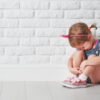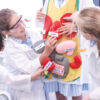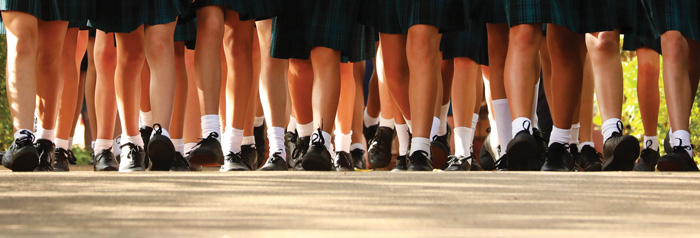
by Kim Jackson M.S.S.F.
Klodhoppers, Haywards Heath
Before you know it the summer holidays are almost over and it’s time to get your children ready for their new academic year, or perhaps they’re even starting school for the first time.
Leaving the purchase of their uniform, school shoes and other school essentials until the last minute is not advisable – it’s just too stressful!
Hopefully, lockdowns are a thing of the past and a ‘proper’ pair of school shoes is what’s needed to protect your child’s long-term foot health.
Going to your fully qualified shoe fitter for a professional measure and fit is essential, so throw away those ill-fitting supermarket school shoes and the dodgy sizing gauges you’ve printed off the Internet, and put your children’s feet in our safe hands.
School shoes should be sturdy, durable, comfortable and preferably breathable as it is your child’s main item of footwear for six or seven hours a day, five days a week. It can be a false economy to choose a cheap pair which you may have to replace several times, when you only really need one or two pairs per academic year, depending on your child’s growth.
Due to their growth spurts it’s definitely two pairs of school shoes per year for primary age children – if not, then it’s very likely that they are in the wrong sized shoe. However, it may only be one pair per academic year for older (secondary age) children as their feet start to mature and the rapid growth spurts reduce.
Here are some of the FAQ’s asked by parents who visit Klodhoppers:
When is the best time to buy school shoes for my child?
Shop early is our advice. Our shoes are delivered to us during July, just as the schools are breaking up for the holidays. This is when the collection is strongest and there is the best selection of all the styles and size runs. If you leave it until the last week of the holidays then there isn’t much left to choose from.
My child has specific foot health requirements, so when should I time my school shoe buying?
Again, shop early for a child with specific foot health or size issues. If your child has very wide or narrow feet, hypermobility, or wears orthotic inserts, then ‘early’ is the best time to come and buy – and remember to bring the orthotic inserts with you too! Please make us aware of any special requests beforehand so that we can assist you and your child fully and to the best of our abilities.
My son is autistic and doesn’t like shopping for shoes in crowded spaces with lots of noise. Can you help us?
Yes. At Klodhoppers we specialise in offering appointments for children with autism and other special needs. Depending on these needs we can book you in for a fitting at the beginning or the end of the day, when we are closed to other customers. If your child prefers to be in the shop with the lights or the music off, and minimal members of staff around then we can accommodate this too. Please talk to us and let us know how we can assist you and your child.
I don’t want to buy school shoes early as my child is bound to grow over the summer holidays. What should I do?
This is more of a myth than reality. Occasionally some children will have a growth spurt in the six weeks of the summer break, but it is not a good reason for leaving your school shoe buying until the last minute. When we fit school shoes early in the summer holiday we always fit with this in mind and tend to err on the generous side with our sizing. Buying school shoes on the day before they are due to return to the classroom can mean a fraught time running around looking for the preferred style, size or brand, with limited choice available. Also it won’t allow your child sufficient time to wear them around the house beforehand in order to soften up the leather, which is something we always advise. Furthermore it helps them get used to wearing a structured shoe again – especially if they have been wearing sandals, trainers or flip flops all summer. A fitted shoe may feel ‘tight’ until the leather softens.
My son wants to wear black trainers to school as his school’s uniform policy is very relaxed. I would prefer for him to have a proper shoe. What should I do?
Wearing trainers for school all the time is not advisable for developing feet, especially as it is likely that he will be wearing trainers at the weekend too. Boys’ feet keep growing until they are approximately 18 years old (girls’ feet reach their adult size a little earlier – usually mid-teens.) Trainers may be very comfortable and lightweight but they encourage the feet to spread over time and become flaccid. They are designed for sports and casual wear, and should not be a school shoe substitute. If your son really wants to wear trainers then perhaps you can compromise with him and buy a school shoe that has the look of a trainer but has all the support of a proper shoe.
My child is going to be starting in Reception. Is there any specific advice for the first pair of school shoes?
You may want to consider a style with a ‘toe bumper’ or scuff guard, and certainly avoid buckles or laces. A lot of reception children spend time on their knees on the classroom carpet and the toes of their school shoes tend to wear through more quickly than usual. Or perhaps they have a climbing wall, or like to play football in the playground at break times, or even scoot to school – this extra wear and tear can have a detrimental effect on their school shoes. You could encourage your child to put on her new school socks and shoes and have a good walk around the house (while they are still clean) a few days in the lead up to school starting. If they do this for 10 to 15 minutes each day then it will allow them to get used to the shoes and for the new leather to soften up. This way the shoes won’t feel too ‘stiff’ on the first day.
Remember that school shoes are NOT indestructible! Children will always find a way to damage or destroy them!
Also, with younger children especially, they are not intended to last a full school academic year without having them checked for growth spurts.
So here’s to a stress-free ‘back to school’ shoe season to you all. Your child only has one pair of feet to see them through life – make sure they are looked after with great care.
Remember to look for the Society of Shoe Fitters logo and/or the Children’s Foot Health Register to ensure you are putting their foot health in the best qualified hands.
Kim Jackson M.S.S.F (Member of the Society of Shoe Fitters & Children’s Foot Health Register accredited) Klodhoppers, Haywards Heath.


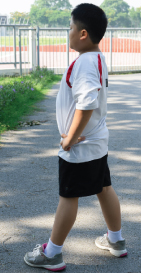
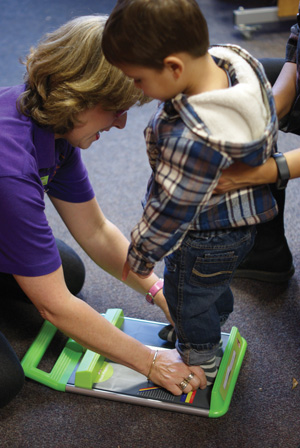
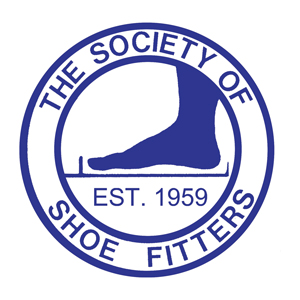 Having over 30 years combined shoe-fitting experience, we could line up at least 10 pairs of the same size shoe, but if they are all 10 different brands, even if they are similar styles, we can guarantee that they will all fit slightly differently on one child’s feet! Some of those fits will be better than others – this is where our guidance, advice, knowledge and expertise comes into play.
Having over 30 years combined shoe-fitting experience, we could line up at least 10 pairs of the same size shoe, but if they are all 10 different brands, even if they are similar styles, we can guarantee that they will all fit slightly differently on one child’s feet! Some of those fits will be better than others – this is where our guidance, advice, knowledge and expertise comes into play.

